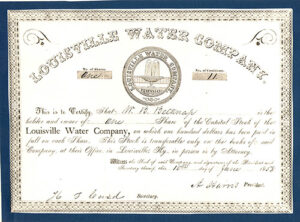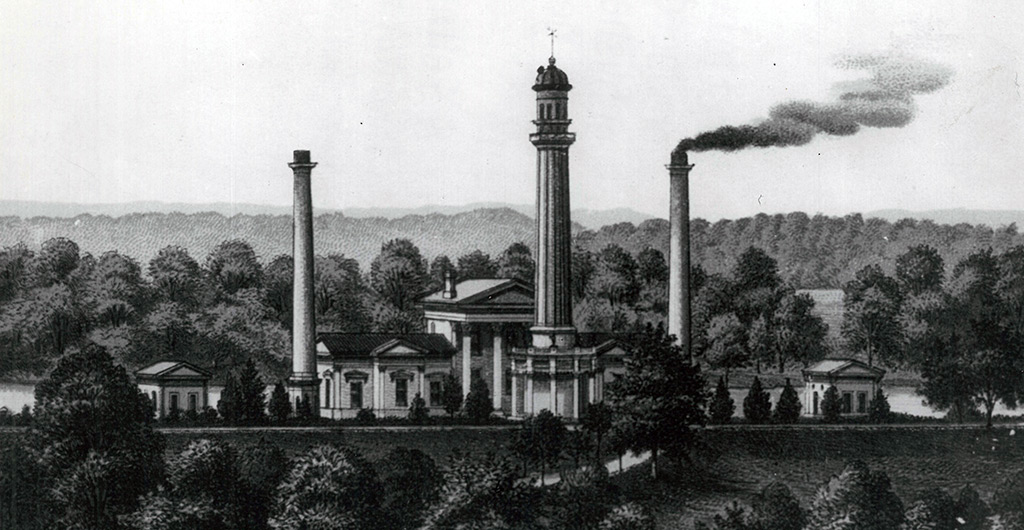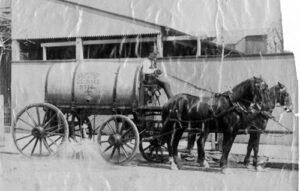On March 6, 1854, the Kentucky legislature voted to create the “Louisville Water Works,” now known as Louisville Water Company – Kentucky’s first public drinking water provider. That vote laid the foundation to improve public health for the citizens of Louisville and eventually, around the world.
 The Louisville Water Works was a private company and on Tuesday, September 9, 1856, shares of stock went on sale for $100 each. Only 51 shares were sold. In 1906, the city of Louisville eventually bought the rest of the shares and the original 51 that were owned by private investors. The city of Louisville became the sole shareholder of a private entity and it’s a governance model that stands today.
The Louisville Water Works was a private company and on Tuesday, September 9, 1856, shares of stock went on sale for $100 each. Only 51 shares were sold. In 1906, the city of Louisville eventually bought the rest of the shares and the original 51 that were owned by private investors. The city of Louisville became the sole shareholder of a private entity and it’s a governance model that stands today.
In 1860, Louisville Water began production on the banks of the Ohio River where Louisville Water Tower and the original pumping station still stand. The original goal was to turn on the water on July 4, 1860, but work wasn’t completed until October.

Newspaper accounts provided a colorful review when Louisville Water started moving water through the pipes.
On October 16, 1860, the Louisville Daily Journal wrote, “It was generally understood that the water would be introduced in the main pipe through the city yesterday, and there was a large attendance of ladies and gentlemen at the Works during the day. The water was actually turned on late in the day for the purpose of trying the pipes. Some trifling leaks were discovered on Main Street, but the experiment was said to be altogether satisfactory.”
This October marks 165 years of delivering high-quality drinking water to Louisville and beyond. From steam engines to advanced meters, Louisville Water has a long history of innovation and reliability.
As one of the oldest water utilities in the country, Louisville Water is credited for many things but most of all, it’s known for its century-long commitment to public health and safety.
Early uses of water
 It was actually a fire – and not public health – that sparked the decision to create the Water Works.
It was actually a fire – and not public health – that sparked the decision to create the Water Works.
After many failed votes to create a water company, it wasn’t until the fire of 1840 nearly destroyed downtown Louisville, that the city finally gave in. After all, most people had a well in their backyard and could get water for free. Why would they want to pay for it?
However, residents insisted a public water service was needed to protect the homes and businesses from fires. The only defense they had at the time was a bucket brigade, which involved passing buckets of water down an assembly line of people to fight the fire. It was actually a law that anyone who made over $40 per year, had to keep two buckets of water readily available at all times.
Once founded, Louisville Water installed “plugs” into cisterns so the fire department could easily access water for a fire.
By 1868, Louisville Water’s 11th annual report noted there were 180 cistern plugs, which would now be considered fire hydrants. Today, Louisville Water manages more than 25,000 public fire hydrants.
 Ironically, early uses of Louisville’s water often had little to do with drinking it. Besides fighting fires, Louisville Water also supported “beautifying streets”.
Ironically, early uses of Louisville’s water often had little to do with drinking it. Besides fighting fires, Louisville Water also supported “beautifying streets”.
In 1861, the city council directed Louisville Water to place “hose plugs upon the sidewalk at the intersections of such streets and alleys as may be necessary to supply water for carts to sprinkle the streets.” This practice continued into the 1920s.
Hydraulic elevators were another popular water user. By 1896, 149 establishments (mostly stores) had attachments for hydraulic elevators, using the waterpower to move goods and people up and down.
Applying for water service
 Water is something many of us take for granted but it was a luxury in 1860. Applying for water service was a big deal – not everyone was approved to receive it.
Water is something many of us take for granted but it was a luxury in 1860. Applying for water service was a big deal – not everyone was approved to receive it.
In 1861, the city council requested Louisville Water provide water service to a hospital.
In 1863, the Board of Water Works rejected applications for water “plugs” for fish vendors but approved a butcher shop’s request, as long as the butchers paid for the water.
In 1889, Louisville Water received a request from W. H. Dillingham, living on Broadway, asking for his meter to be moved as he claimed it restricted water flow to a water-powered organ.
Decades later, water service remains a big deal to us. We’ve expanded our reach from 512 customers to more than 300,000 customer accounts and serve far beyond Jefferson County. Nearly one million people rely on Louisville Water today – that’s 20% of Kentucky’s population. Every time we break ground on a new water main or deliver water to a new county, it’s another milestone worth celebrating.
Follow along for more Louisville Water history as we celebrate 165 years of delivering high-quality water this month. Cheers!

